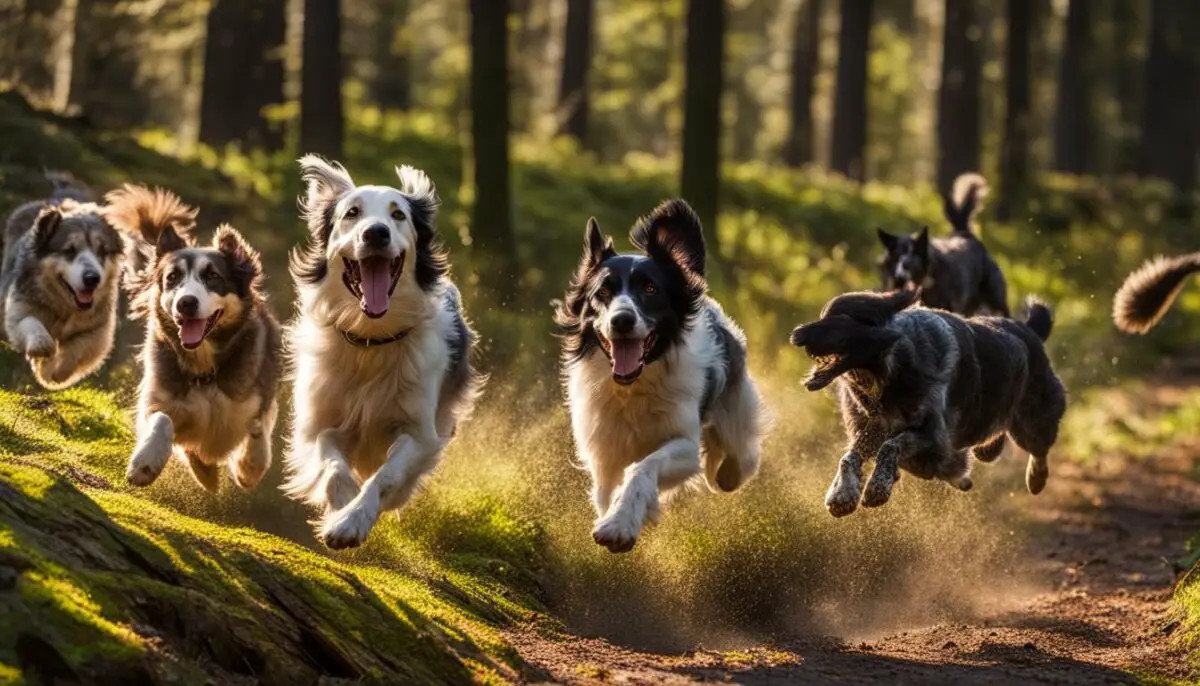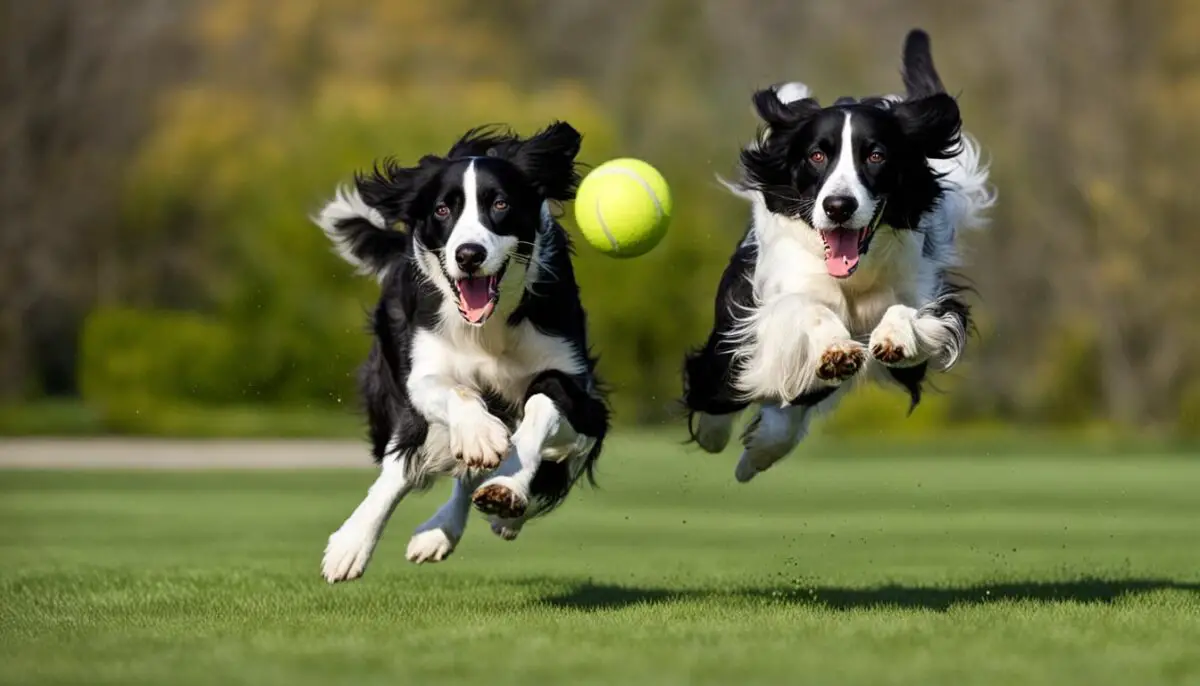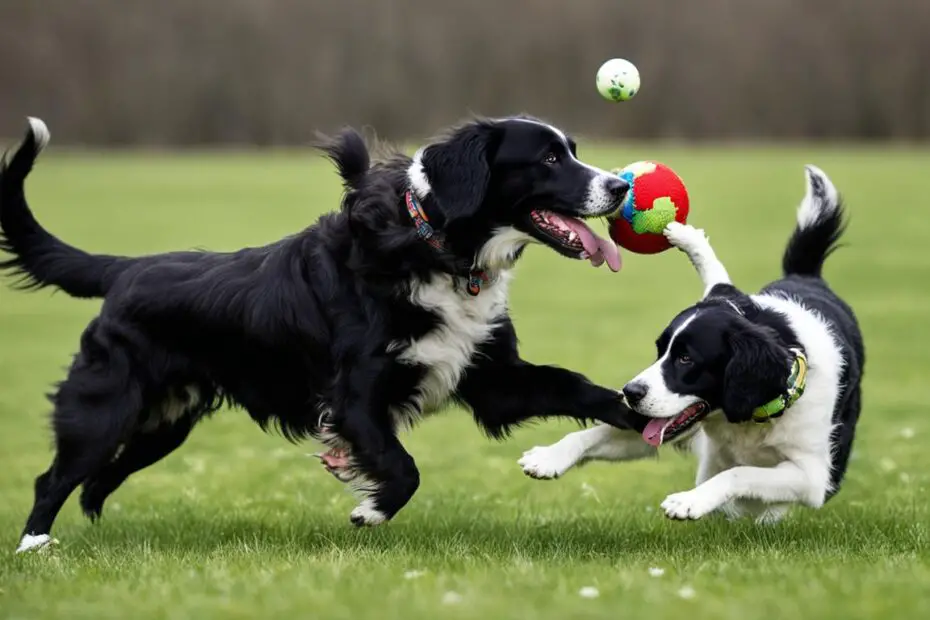Welcome to our complete guide to Munsterlander dogs! Whether you’re looking for a versatile hunting dog, a loyal companion, or a medium-sized family pet, the Munsterlander is an intelligent and trainable breed that fits the bill. With their German Longhaired Pointer origins, these dogs have a rich history as gun dogs and make wonderful additions to any household.
Munsterlanders come in two sizes: the Large Munsterlander and the Small Munsterlander. Both are well-proportioned dogs with flowing coats and feathering on their legs and tail. The Large Munsterlander weighs around 25-29kg for males and 25kg for females, while the Small Munsterlander weighs 15-17kg. They are medium-sized dogs that are known for their loyalty and adaptability.
These intelligent breeds require experienced owners and extra training to bring out their full potential. They thrive on vigorous walks and need more than two hours of exercise per day. While they may drool and require regular grooming, they are generally quiet dogs who will bark to alert you of visitors. They are friendly with other dogs and can be trained to get along with other pets. However, they may need additional supervision when living with children, and a large garden is preferred for their outdoor exercise needs.
In this guide, we will explore the breed history, temperament, characteristics, and offer valuable training and care tips for Munsterlander dogs. Let’s dive in!
Key Takeaways:
- Munsterlanders are versatile hunting dogs and loyal family companions.
- They require experienced owners and extra training to bring out their full potential.
- These medium-sized dogs are intelligent, trainable, and adaptable.
- Munsterlanders need ample exercise, mental stimulation, and grooming.
- They can get along with other dogs and can be trained to live with other pets when properly introduced.
Munsterlander Breed History
The Munsterlander dogs, including the Small and Large Munsterlander, have a rich and fascinating breed history that dates back centuries. These versatile hunting breeds have evolved and developed over time, resulting in their distinctive characteristics and traits.
The Munsterlander originated in the Munsterland region of Germany as a German Spaniel. It is believed that the breed’s separation into different sizes occurred in the middle of the 19th century. Artwork from the Middle Ages depicted dogs that strongly resembled the Munsterlander, indicating their presence in Europe since the 13th or 14th century.
The Small and Large Munsterlander were officially recognized by the United Kennel Club in 2006, solidifying their status as distinct breeds within the Munsterlander family.
The breed standard for the Small Munsterlander specifies a height of 19 to 23 inches at the shoulder, while the Large Munsterlander stands slightly taller at 23 to 25 inches. These measurements provide a guideline for breeders and enthusiasts to maintain the desired size and proportions of the Munsterlander dogs.
It is believed that Longhaired Pointers were crossed with Spaniels to create the Munsterlander, further enhancing their hunting abilities and overall characteristics.
The breed’s documented history dates back to 1870, with the first Munsterlanders arriving in the United States in 1966. Enthusiasts in America have formed dedicated clubs such as the Large Munsterlander Club of America and the Small Munsterlander Club of America, fostering a community of passionate owners and breed enthusiasts.

The Munsterlander breed history is a testament to their enduring presence and significant contributions as versatile hunting dogs. Their origins, development, and recognition by kennel clubs reflect the breed’s unique qualities and appeal to dog lovers worldwide.
Munsterlander Temperament
The Munsterlander dogs, both the Large Munsterlander and the Small Munsterlander, have distinct temperaments that make them unique and wonderful companions.
Large Munsterlander
The Large Munsterlander is a quick learner and highly trainable. They possess a sharp intellect and are receptive to various training methods. They excel in obedience and hunting training, showcasing their versatility and adaptability. However, they require a light touch and plenty of positive reinforcement to thrive. Their sensitive nature demands consistent training to prevent destructive behavior and promote good manners.
Recognized as a sporting breed, the Large Munsterlander has high energy levels and a strong drive to work. They have a keen desire to please their owners and excel in various activities such as agility, tracking, and search and rescue. Regular mental stimulation is essential to keep their active minds engaged and fulfilled.
Small Munsterlander
The Small Munsterlander is an adaptable and self-confident breed. They thrive in a working environment where they can utilize their exceptional hunting skills effectively. Their natural instincts and versatility make them excellent bird dogs, able to track and retrieve game effortlessly.
In addition to their hunting prowess, the Small Munsterlander displays a remarkable affectionate side, making them wonderful family companions. They are loyal, loving, and highly dedicated to their owners. Their high energy levels require substantial exercise and mental stimulation to prevent boredom and destructive behaviors.
| Large Munsterlander | Small Munsterlander |
|---|---|
| Quick learner and highly trainable | Adaptable and self-confident |
| Sensitive and requires constant training | Best-suited for a working home |
| High energy and requires lots of exercise | Affectionate and makes a great family companion |
| High exercise needs to prevent boredom and destructive behavior |
The Munsterlander breeds are characterized by their good temperaments and make loving additions to a family. While they possess unique traits, both breeds require consistent training and plenty of mental and physical exercise to thrive and be well-balanced companions.

Large Munsterlander Breed Characteristics
The Large Munsterlander is known for its impressive breed characteristics, making it a popular choice among dog enthusiasts. Here are some key features of the Large Munsterlander:
| Traits | Description |
|---|---|
| Appearance | The Large Munsterlander has a muscular build and is considered strong and stocky. They have an aristocratic and intelligent appearance, captivating all who encounter them. |
| Size | Males typically weigh around 30 kilograms and have a height of 60 to 65 centimeters at the withers. Females are slightly smaller in size. |
| Coat | Their coat is dense and long, featuring a striking combination of black and white. The coat may also have different pattern variations, adding to their unique allure. |
| Trainability | The Large Munsterlander is docile and easily trained, showcasing good leadership skills. They are intelligent and receptive, making training sessions a breeze. |
| Hunting Abilities | As a versatile hunting breed, the Large Munsterlander is renowned for its reliable hunting skills. They are particularly skilled at retrieving game, a testament to their aptitude as reliable hunters. |
| Temperament | The Large Munsterlander is lively yet rarely nervous, displaying neither fearful nor aggressive behavior. With proper training and socialization, they are suitable as family dogs. |
| Compatibility | The Large Munsterlander is alert and can get along well with children and other dogs. They have a balanced temperament that contributes to their harmonious interactions. |
| Exercise Needs | The Large Munsterlander thrives on outdoor exercise and requires regular mental and physical stimulation. |
To catch a glimpse of the regal Large Munsterlander, take a look at the image below:
Conclusion
Munsterlander dogs are a versatile hunting breed that excel in various field sports, making them an ideal choice for avid hunters. However, their skills extend beyond their hunting capabilities, as they also thrive as loyal family companions. These intelligent and trainable dogs require experienced owners who can provide them with the necessary mental stimulation and vigorous exercise to fulfill their high energy needs.
When it comes to training Munsterlanders, positive reinforcement and a gentle approach work best. Their intelligence allows them to quickly grasp commands and make them an obedient and well-behaved addition to any household. However, it’s important to note that their training should be consistent and ongoing to prevent any destructive behaviors.
Both the Large and Small Munsterlanders possess good temperaments and can coexist harmoniously with children and other dogs when properly socialized and trained. However, their grooming needs should not be overlooked, as their flowing coats require regular care to keep them looking their best.
In conclusion, Munsterlanders are a loving and dedicated breed that thrives in the right environment with the right care and training. Whether you’re a passionate hunter looking for a versatile hunting companion or seeking a loyal family pet, Munsterlander dogs are sure to bring joy and companionship to your life.
FAQ
What is a Munsterlander dog?
A Munsterlander dog is a versatile hunting breed that originated in the Munsterland region of Germany. They are medium-sized dogs known for their flowing coats and were initially bred as German Spaniels.
Are Munsterlanders good family pets?
Yes, Munsterlanders can make loyal family companions. However, they require experienced owners, extra training, and a large garden for outdoor exercise. They can get along well with children and other dogs when properly trained.
Are Munsterlanders intelligent?
Yes, Munsterlanders are an intelligent breed. They are quick learners and highly trainable, but they require constant mental stimulation to prevent boredom and destructive behavior.
How much exercise do Munsterlanders need?
Munsterlanders are high-energy dogs that require vigorous exercise. They need more than two hours of exercise per day, including both physical and mental stimulation.
What is the lifespan of a Munsterlander?
Munsterlanders have a lifespan of 12-13 years on average.
Do Munsterlanders require grooming?
Yes, Munsterlanders have dense and long coats that require grooming every other day to keep them looking their best.
Can Munsterlanders get along with other pets?
With proper training and socialization, Munsterlanders can get along well with other dogs and other pets.
Do Munsterlanders bark a lot?
Munsterlanders are generally quiet, but they will bark and alert to visitors or potential threats.
